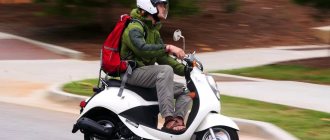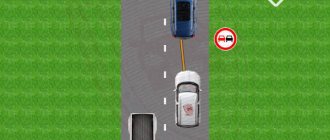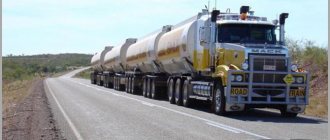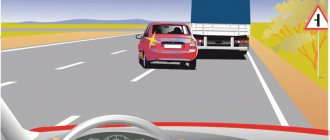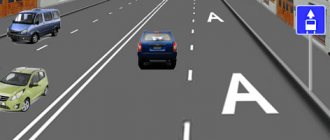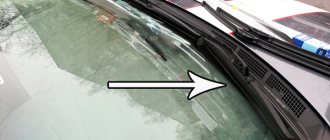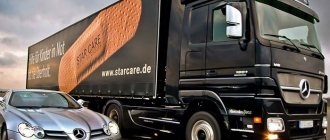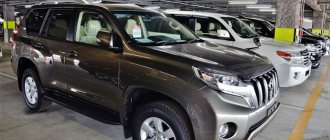Good afternoon, dear reader.
In 2021, the technical regulations of the Customs Union on the safety of wheeled vehicles will be applied in Russia. This regulatory document contains requirements for the technical condition of vehicles. Compliance with these requirements is also verified during a technical inspection of the vehicle.
The technical regulations of the customs union came into force quite a long time ago, but not every driver had to deal with them. The peculiarity of the regulation is that it uses special categories of vehicles that have not previously been found in regulatory legal documents.
This article will discuss the categories of vehicles in the regulations, as well as the vehicles to which these categories relate:
- Table of categories in technical regulations.
- Motorized vehicles: Mopeds, motorbikes, mokicks.
- Motorcycles, scooters, tricycles.
- Quadricycles.
- Passenger cars.
Table of categories in technical regulations
| Category of technical regulations | Decoding |
| L1-L2 | Mopeds, motorbikes, mokikis |
| L3-L5 | Motorcycles, scooters, tricycles |
| L6-L7 | Quadricycles |
| M1 | Passenger cars |
| M2-M3 | Buses, trolleybuses, specialized passenger vehicles |
| N1-N3 | Trucks |
| O1-O4 | Trailers |
L - motor vehicles
This category includes:
Mopeds, motorbikes, mokikis
L1 - two-wheeled vehicles whose maximum design speed does not exceed < 50 km/h and are characterized by:
- in the case of an internal combustion engine - with an engine displacement not exceeding < 50 cubic meters. cm
- in the case of an electric motor - rated maximum power in continuous load mode, not exceeding < 4 kW .
L2 - three-wheeled vehicles with any wheel arrangement, the maximum design speed of which does not exceed < 50 km/h , and characterized by:
- in the case of an internal combustion engine with forced ignition - an engine displacement not exceeding < 50 cc. cm
- in the case of another type of internal combustion engine - a maximum effective power not exceeding < 4 kW
- in the case of an electric motor - rated maximum power in continuous load mode, not exceeding < 4 kW .
Motorcycles, scooters, tricycles
L3 or classic motorcycles are two-wheeled vehicles whose engine displacement (in the case of an internal combustion engine) exceeds > 50 cc. cm (or) the maximum design speed (with any engine) exceeds > 50 km/h.
L4 - three-wheeled vehicles with wheels asymmetrical with respect to the median longitudinal plane, the engine displacement of which (in the case of an internal combustion engine) exceeds > 50 cc. cm and/or the maximum design speed (with any engine) exceeds > 50 km/h . Essentially, these are motorcycles with a sidecar.
More on the topic: How to restore a vehicle registration certificate if lost
L5 or tricycles are three-wheeled vehicles with wheels symmetrical with respect to the median longitudinal plane of the vehicle, the engine displacement of which (in the case of an internal combustion engine) exceeds > 50 cc. cm and/or the maximum design speed (with any engine) exceeds > 50 km/h .
Quadricycles
These are four-wheeled vehicles, divided depending on engine size and weight into:
L6 - the unladen mass of such ATVs does not exceed <350 kg excluding the mass of batteries (in the case of an electric vehicle), the maximum design speed does not exceed <50 km/h , and characterized by:
- in the case of an internal combustion engine with forced ignition - an engine displacement not exceeding < 50 cc. cm
- in the case of another type of internal combustion engine - maximum effective engine power not exceeding < 4 kW
- in the case of an electric motor - the rated maximum power of the motor in continuous load mode, not exceeding < 4
L7 - ATVs other than those described in category L6, i.e. more than 50 cubic meters cm. Their unladen mass does not exceed <400 kg (550 kg for vehicles intended for the transport of goods) excluding the mass of batteries (in the case of an electric vehicle) and the maximum effective engine power does not exceed <15 kW.
Motor vehicles
Mopeds, motorbikes, mokikis
Category L1 - Two-wheeled vehicles whose maximum design speed does not exceed 50 km/h and characterized by:
- in the case of an internal combustion engine - with an engine displacement not exceeding 50 cm3, or
- in the case of an electric motor - rated maximum power in continuous load mode, not exceeding 4 kW.
Category L2 - Three-wheeled vehicles with any wheel arrangement, the maximum design speed of which does not exceed 50 km/h, and characterized by:
- in the case of an internal combustion engine with forced ignition - an engine displacement not exceeding 50 cm3, or
- in the case of another type of internal combustion engine - a maximum effective power not exceeding 4 kW, or
- in the case of an electric motor - rated maximum power in continuous load mode, not exceeding 4 kW.
With scooters the situation is quite simple:
- If the scooter has 2 wheels, then it belongs to category L1.
- If the scooter has 3 wheels, then it belongs to category L2.
Thus, categories L1-L2 correspond to motor vehicles, which require a driver’s license of category M to drive.
Motorcycles, scooters, tricycles
Category L3 - Two-wheeled vehicles whose engine displacement (in the case of an internal combustion engine) exceeds 50 cm3 (or) the maximum design speed (for any engine) exceeds 50 km/h.
Category L4 - Three-wheeled vehicles with wheels asymmetrical with respect to the median longitudinal plane, the engine displacement (in the case of an internal combustion engine) exceeds 50 cm3 and (or) the maximum design speed (for any engine) exceeds 50 km/h.
Category L5 - Three-wheeled vehicles with wheels symmetrical with respect to the median longitudinal plane of the vehicle, the engine displacement (in the case of an internal combustion engine) exceeds 50 cm3 and (or) the maximum design speed (for any engine) exceeds 50 km/h .
If the distance between the centers of the contact patches with the road surface of the wheels of one axle is less than 460 mm, such vehicles belong to category L3.
Categories L3-L5 refer to vehicles that require a category A driver's license to drive:
- L3 - two-wheeled motorcycles, as well as three-wheeled motorcycles with a small distance between the wheels on the axle (less than 46 cm);
- L4 - asymmetrical three-wheeled motorcycles (for example, a motorcycle with a sidecar);
- L5 - symmetrical three-wheeled motorcycles (for example, a motorcycle with a body in the center).
Quadricycles
Category L6 - Four-wheeled vehicles whose unladen mass does not exceed 350 kg excluding the mass of batteries (in the case of an electric vehicle), the maximum design speed does not exceed 50 km/h, and characterized by:
- in the case of an internal combustion engine with forced ignition - an engine displacement not exceeding 50 cm3, or
- in the case of another type of internal combustion engine, a maximum effective engine power not exceeding 4 kW, or
- in the case of an electric motor - the rated maximum power of the engine in continuous load mode, not exceeding 4 kW.
Category L7 - Four-wheeled vehicles other than vehicles of category L6, the unladen mass of which does not exceed 400 kg (550 kg for vehicles intended for the carriage of goods) excluding the mass of batteries (in the case of an electric vehicle) and the maximum effective power motor does not exceed 15 kW.
From the point of view of traffic rules, quadricycles of category L6 are mopeds, i.e. to drive them, a category M license is required. More powerful quadricycles of category L7 require subcategory B1 licenses.
The division between categories L6 and L7 is made solely on the basis of engine power. More powerful quadricycles belong to the L7 category.
Category L - Motor vehicles
Mopeds, motorbikes, mokikis
Category L1 - Two-wheeled vehicle, the maximum design speed of which does not exceed 50 km/h, and is characterized by:
- in the case of an internal combustion engine - with an engine displacement not exceeding 50 cubic meters. cm, or
- in the case of an electric motor - rated maximum power in continuous load mode, not exceeding 4 kW.
Category L2 - Three-wheeled vehicle with any arrangement of wheels, the maximum design speed of which does not exceed 50 km/h, and characterized by:
- in the case of an internal combustion engine with forced ignition - an engine displacement not exceeding 50 cubic meters. cm, or
- in the case of another type of internal combustion engine - a maximum effective power not exceeding 4 kW, or
- in the case of an electric motor - rated maximum power in continuous load mode not exceeding 4 kW
Motorcycles, scooters, tricycles
Category L3 - Two-wheeled vehicle whose engine displacement (in the case of an internal combustion engine) exceeds 50 cc. cm (or) the maximum design speed (with any engine) exceeds 50 km/h.
Category L4 - Three-wheeled vehicle with wheels asymmetrical with respect to the median longitudinal plane, the engine displacement (in the case of an internal combustion engine) exceeds 50 cm3 and (or) the maximum design speed (for any engine) exceeds 50 km/h.
Category L5 - Three-wheeled vehicle with wheels symmetrical with respect to the median longitudinal plane of the vehicle, the engine displacement of which (in the case of an internal combustion engine) exceeds 50 cubic meters. cm and (or) the maximum design speed (for any engine) exceeds 50 km/h.
Quadricycles
Category L6 - Four-wheeled vehicle, the unladen mass of which does not exceed 350 kg excluding the mass of batteries (in the case of an electric vehicle), the maximum design speed does not exceed 50 km/h, and characterized by:
- in the case of an internal combustion engine with forced ignition - an engine displacement not exceeding 50 cm3, or
- in the case of another type of internal combustion engine, a maximum effective engine power not exceeding 4 kW, or
- in the case of an electric motor - the rated maximum power of the engine in continuous load mode, not exceeding 4 kW.
Category L7 - Four-wheeled vehicle, other than a vehicle of category L6, the unladen mass of which does not exceed 400 kg (550 kg for a vehicle intended for the carriage of goods) excluding the mass of batteries (in the case of an electric vehicle) and the maximum effective power of the engine does not exceed 15 kW.
Passenger vehicles
Passenger cars
Category M1 - Vehicles used for the transport of passengers and having, in addition to the driver's seat, no more than eight seats - passenger cars.
Let's consider category M1, which refers to passenger vehicles. It is this category that will be of interest to most car owners, since category M1 corresponds to category B of a regular driver’s license.
So if you are looking for requirements related to a passenger car in the technical regulations, then you should pay attention exclusively to the items related to the M1 category.
Please note that Category M1 does not include goods vehicles of Category B. These will be discussed below.
Buses, trolleybuses, specialized passenger vehicles
Category M2 - Vehicles used for the transport of passengers, having, in addition to the driver's seat, more than eight seats, the technically permissible maximum weight of which does not exceed 5 tons.
Category M3 - Vehicles used for the transport of passengers, having, in addition to the driver's seat, more than eight seats, the technically permissible maximum mass of which exceeds 5 tons
Passenger buses and trolleybuses, depending on their weight, fall into categories M2 and M3. Thus, categories M2 and M3 correspond to category D of a regular driving license.
In addition, if the bus has from 1 to 8 passenger seats, then the vehicle belongs to category B.
Categories of vehicles according to the international system
Group L includes any vehicles with fewer than four wheels, as well as ATVs:
- L1 is a moped or vehicle with two wheels that can reach a maximum speed of 50 km/h. If the vehicle has an internal combustion engine, its volume should not exceed 50 cm³. If an electric motor is used as a power unit, then the power ratings must be less than 4 kW;
- L2 – three-wheeled moped, as well as any vehicle with three wheels, the speed of which does not exceed 50 km/h, and the engine capacity is 50 cm³;
- L3 is a motorcycle with a volume of more than 50 cm³. Its maximum speed is higher than 50 km/h;
- L4 – a motorcycle equipped with a sidecar for carrying a passenger;
- L5 – tricycles whose speed exceeds 50 km/h;
- The L6 is a lightweight quad bike. The weight of the equipped vehicle must not exceed 350 kg; Maximum speed no more than 50 km/h;
- L7 is a full-fledged quad bike with a weight of up to 400 kg.
Category M – these are motor vehicles with four wheels for transporting passengers:
- M1 is a vehicle for transporting passengers with no more than 8 seats;
- M2 – vehicle with more than eight seats for passengers;
- M3 – vehicle with more than 8 seats and weighing up to 5 tons;
- M4 is a vehicle with more than eight seats and a weight of over 5 tons.
According to the international classification, category N includes trucks:
- N1 – trucks weighing up to 3.5 tons;
- N2 – vehicles weighing from 3.5 to 12 tons;
- N3 – vehicles weighing more than 12 tons.
Trucks
Category N1 - Vehicles intended for the transport of goods, having a technically permissible maximum weight of not more than 3.5 tons.
Category N2 - Vehicles intended for the transport of goods, having a technically permissible maximum weight of over 3.5 tons, but not more than 12 tons.
Category N3 - Vehicles intended for the transport of goods, having a technically permissible maximum weight of more than 12 tons.
Trucks belong to category N of the technical regulations, within which they, like buses, are divided into subcategories by weight.
Trucks of category B correspond to category N1 of the technical regulations, trucks of category C correspond to categories N2 and N3.
Category L - motor vehicles with fewer than four wheels and quadricycles
2.1 Category L1. Two-wheeled moped. A two-wheeled vehicle whose maximum design speed does not exceed 50 km/h, characterized by:
- in the case of an internal combustion engine - with an engine displacement not exceeding 50 cm³, or
- in the case of an electric motor - rated maximum power in continuous load mode, not exceeding 4 kW.
2.2 Category L2. Three-wheeled moped. A three-wheeled vehicle with any wheel arrangement, the maximum design speed of which does not exceed 50 km/h, characterized by:
- in the case of an internal combustion engine with forced ignition - an engine displacement not exceeding 50 cm³, or
- in the case of another type of internal combustion engine - a maximum effective power not exceeding 4 kW, or
- in the case of an electric motor - rated maximum power in continuous load mode, not exceeding 4 kW.
2.3 Category L3. Motorbike. A two-wheeled vehicle whose engine displacement (in the case of an internal combustion engine) exceeds 50 cm³ and/or whose maximum design speed (for any engine) exceeds 50 km/h.
2.4 Category L4. Motorcycle with sidecar. A three-wheeled vehicle with wheels asymmetrical with respect to the median longitudinal plane, the engine displacement (in the case of an internal combustion engine) exceeds 50 cm³ and (or) the maximum design speed (for any engine) exceeds 50 km/h.
2.5 Category L5. Tricycle. A three-wheeled vehicle with wheels symmetrical with respect to the median longitudinal plane of the vehicle, the engine displacement (in the case of an internal combustion engine) exceeds 50 cm³ and (or) the maximum design speed (for any engine) exceeds 50 km/h.
2.6 Category L6. Lightweight quadricycle. A four-wheeled vehicle, the unladen mass of which does not exceed 350 kg excluding the mass of batteries (in the case of an electric vehicle), the maximum design speed does not exceed 50 km/h, characterized by:
- in the case of an internal combustion engine with forced ignition - an engine displacement not exceeding 50 cm³, or
- in the case of another type of internal combustion engine, a maximum effective engine power not exceeding 4 kW, or
- in the case of an electric motor - the rated maximum power of the motor in continuous load mode not exceeding 4 kW.
2.7 Category L7. Quadricycle. A four-wheeled vehicle other than a vehicle of category L6, the unladen mass of which does not exceed 400 kg (550 kg for a vehicle intended for the carriage of goods) excluding the mass of batteries (in the case of an electric vehicle) and the maximum effective engine power does not exceed 15 kW
Trailers
Category O1 - Trailers whose technically permissible maximum weight is not more than 0.75 tons.
Category O2 - Trailers with a technically permissible maximum weight of more than 0.75 tons, but not more than 3.5 tons.
Category O3 - Trailers with a technically permissible maximum weight of more than 3.5 tons, but not more than 10 tons.
Category O4 - Trailers with a technically permissible maximum weight of more than 10 tons.
Category O includes all trailers and semi-trailers, which are also classified according to their permissible maximum weight.
Trailers of category O1 can be driven without category E on the driver's license.
Categories O2, O3, O4 correspond to any of the categories E to B, E to C, E to D of a driver’s license.
M - vehicles for transporting passengers
All vehicles in this category have at least four wheels
Cars
M1 - vehicles used for the carriage of passengers and having, in addition to the driver's seat, no more than eight seats .
Buses, trolleybuses, specialized passenger vehicles and their chassis
M2 or minibuses are vehicles used for the transport of passengers, having, in addition to the driver's seat, more than eight seats , and whose technically permissible maximum mass does not exceed < 5 tons.
More on the topic: What to do if, after selling the car, the new owner does not register it
M3 - vehicles used for the transport of passengers, having, in addition to the driver's seat, more than eight seats , the technically permissible maximum weight of which exceeds > 5 tons. In fact, these are all city and intercity buses.
Vehicles of categories M2 and M3 with a capacity of no more than 22 passengers in addition to the driver are divided into class A , intended for the carriage of standing and seated passengers, and class B , intended for the carriage of seated passengers only.
Vehicles of categories M2 and M3 with a capacity of more than 22 passengers in addition to the driver are divided into class I , having a dedicated area for standing passengers and providing a quick change of passengers, class II , intended for the carriage of predominantly seated passengers and having the ability to transport standing passengers in the aisle and ( or) in an area not exceeding the area of a double passenger seat, and class III , intended for the carriage of exclusively seated passengers.
Categories of mechanical vehicles
- This category includes motorcycles. It is a two-wheeled or three-wheeled vehicle that is equipped with a functional mechanical engine. It comes in pneumatic, electric and internal combustion types. The main distinguishing features are the driver's upright seating position, side footrests, and direct control of the front swivel wheels.
- This category includes cars with a permissible maximum weight of no more than 3,500 kilograms. The exception is motor vehicles of group A. The factor that the number of seats other than the driver should not exceed eight is also taken into account. This category also includes cars that have a trailer. But their total weight should not exceed more than 750 kilograms.
- This includes vehicles with a permissible maximum weight of more than 3,500 kilograms. But the total weight cannot exceed 7500 kg.
- This category includes vehicles whose maximum weight does not exceed 750 kilograms.
- These are combinations of vehicles that have a tractor. Also included in this category are trucks with trailers.
